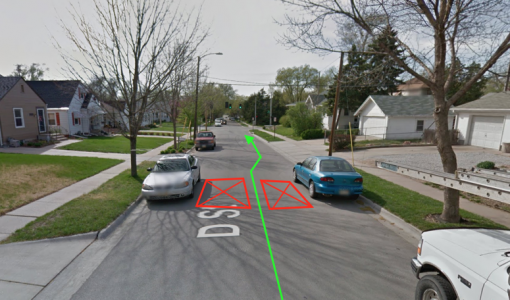I saw him this week, riding down the quiet residential end of Randolph Street – a cyclist whose desire to be polite and stay out of the way led him to ride right down the gutter. At every parked car, he’d pop out into the street, then duck between cars to ride against the curb before popping out again. I feared for him when – pop! – there he was, out in the street, as startled by an approaching car as the car driver was by him. The car driver panic-braked, and the cyclist bailed onto the sidewalk.
If you’re new to riding on roads, you might think the best course of action is to stay as far off to the side as possible. You may have heard that the laws in Nebraska require cyclists to ride “as near to the right-hand curb or right-hand edge of the roadway as practicable” – and they do (Nebraska Revised Statute 60-6,317). But the law also contains a list of exceptions allowing you to move farther left when conditions to the far right are unsafe, or when a lane is narrow. In plenty of situations with similar laws, the “as far right as practicable” definition is vague and troublesome. You may have a completely different idea of what is safe for you than a police officer or a judge does. The riding tactic I’m about to suggest may or may not be considered acceptable based on the law, but I do it because, based on a great deal of experience, it is safe and helps me ride predictably.
This is my advice for being safe and being seen: Stop hugging the curb.
On a clear street, look at the lane you’re in. (Divide a residential street in half, if there are no lane markings.) Often, you can see tire tracks from cars, but if not, imagine where the right set of tires on a car would be. This is a safe default riding position. Why?
- Vehicle drivers approaching on cross streets are looking for other vehicles in the lane. They’re not looking down the curb. In the right tire track, you’re riding where a vehicle driver is looking. Some drivers will still look right at you and not actually see you, but your odds are better if you’re in their line of sight.
- Traffic sweeps glass, rocks, and other sharp and loose debris off to the sides of the street, along the curb. That’s why it’s often not safe for you to be further right than where traffic is. In the right tire track, your path is clear.
- The very edges of streets often get neglected. This is where you’ll find all manner of rough asphalt, holes, and chasms along concrete expansion joints.
When there are cars parked along a street, give them a very wide berth. Any one of those doors could fly open at any minute, and you do not want to hit or be hit by one. On residential streets with parked cars on both sides, you’re safest riding right down the middle while you pass between the cars.
When you stop at a stop sign or a red light – you guessed it. Don’t hug the curb. In fact, you may want to move to the center of the lane. Why?
- Again – visibility! Everyone at that intersection needs to see you. Don’t hide.
- You don’t want to invite vehicle drivers to pull up next to you at the light, squeezing you off to the right and then potentially turning right in front of you. If you let them, they will do it. It’s a very common way for cyclists to be killed. (Likewise: Never file up to the front of a line of vehicles at a light.)
Before you accuse me of willfully impeding traffic, let me clarify: These are default positions, and you can – and should! – deviate from them as needed to facilitate traffic flow. The key is that you need to be seen first, before you move. Think of the dance you do driving your car down a residential street. You’d never duck between every parked car. When you meet an oncoming car, and the road is obstructed by parked cars, either you or other driver momentarily ducks to the side to let the other pass. Drive your bike the same way. And if you hear a vehicle coming up behind you, you may wish to duck over farther to the right – when it’s safe – to let them pass. You might even give a wave to invite them by. But always, always look back before you move back to the left!
In short: Be visible. Be predictable. Be relevant. And, as always, be courteous.

